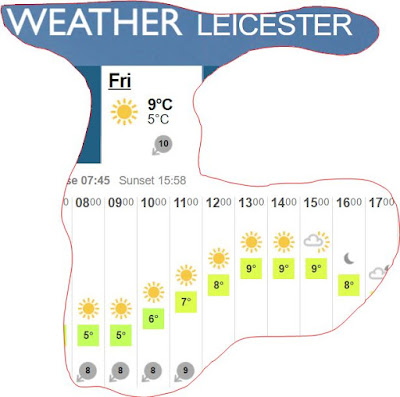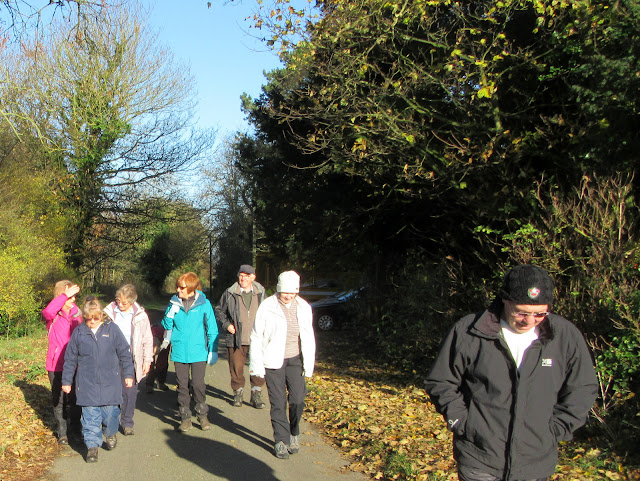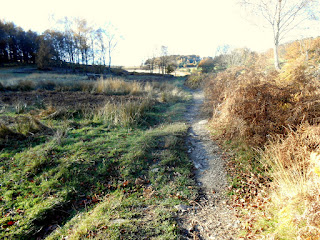The sun was out with a big smile on its face although it was a bit on the chilly side because of the time of year but ideal walking weather. We all headed for the North Car Park in Swithland Woods meeting there just after 11o'clock.
We thought that some photographs would suffer a little with the sun being very low in the sky but it turned out that some were exceptional taking advantage of the low sun. Hey ho!
For info: There are two car parks situated at the north and south entrances to the Wood namely:-
Swithland Wood (south) – (off Roecliffe Road). Wood lies to north of Bradgate Park. (Use Post Code LE12 8TN for SatNav)
Swithland Wood (north) – (off Swithland Lane). Nearest car park to village of Woodhouse Eaves (Use Post Code LE12 8SS for SatNav).
Leaving the car park behind us, all fifteen of us well wrapped up, headed off into the woods. Kids of all ages love this kind of walk, rustling through the leaves in and out of the trees.
Camera at the ready - you never know what's round the corner.
For info: Swithland Wood is an ancient woodland in Charnwood Forest. It's just north of Bradgate Park and also near Woodhouse Eaves and Cropston. It's been a public woodland since 1925, upon the acquisition from the Leicester Rotary Club, having previously been part of the estate of the manor of Groby.
Felled trees are stacked, probably destined to go to the local timber yard. We saw large machinery hauling timber around.
For info: Swithland Wood had been quarried for many centuries for small-scale slate production. Many of the 24 small pits in Swithland Wood may relate to early slate quarrying. Unlike the management of the woodland, the quarries were leased to local quarrymen. Two industrial scale quarries developed within the woods, one in the 'Great Pit' in the centre of the woods, and the other near the road at the northern end. Similar scales of activity also developed on the other side of Swithland Road, in The Brand, where four more water-filled pits remain.
Walking along with our group it's a great time to catch up on the week's events.
Coming out of the woods we took the path that would lead us to Bradgate Park.
Clear skies above the Leicestershire countryside.
 |
| Feeding Time |
The bridle-ways also have their own charm at this time of the year.
After this section of the walk we crossed the road and entered Bradgate Park via the Hallgate's Car Park near the Cropston Reservoir.
For info: Bradgate Park is a public park in Charnwood Forest, in Leicestershire, England, northwest of Leicester. It covers 850 acres. The park lies between the villages of Newtown Linford, Anstey, Cropston, Woodhouse Eaves and Swithland.
Heading down towards the Deer Barn tea room and Visitor Centre, our destination for a well earned cuppa and possibly a cake or scone for some.
 |
| Cropston Reservoir |
In the distance you can see the park rangers cottage (fantastic size garden)
At the Deer Barn we enjoyed our refreshments, choosing the inside rather than the outside seating which was quite cold as it was shaded from the sun.
Leaving the tea rooms we wrapped up and set off on the return leg of the walk.
Hoping to see some deer that one of the walkers had spotted earlier we headed up to the central wall and then turned right back in the direction of Swithland.
Turning immediately left, the herd were sunning themselves near to the central wall.

 |
| A Stag was spotted eating leaves from a tree. |
Leaving the deer behind us we then started to move upwards where spectacular views of the park could be enjoyed.
A bit of a climb but well worth it.
Fabulous autumnal colours.
 |
It's behind you
|
We continued on to the brow of the hill before turning left on to the last stretch of the walk.
Old John, an iconic folly right at the top of Bradgate Park, can just be seen in the distance. We will probably walk up there another time.
For info: This Folly or Prospect Tower was built in 1784 by the 5th Earl of Stamford. The circular stone tower replaced a former wooden windmill (which had been made unsafe in an earlier storm) and stands on Bradgate’s tallest hill and Leicestershire’s second highest point – some 690 feet above sea level.
Constructed in local granite stone with two circular rooms, one above the other, connected by a narrow spiral staircase and complete with timbered floor and three glazed and shuttered windows on first floor, slate fireplaces and castellations around the top of the structure. The windows and castellations may have been incorporated a few years after the Tower was built.
On the way down towards Swithland Woods.
Through the gate, over the road and into Swithland Woods.
Making our way through the woods back to the car park.
.
Back at the car park. Just over 5 miles of walking and cannot wait for next week. Let's have some more winter sun - we really do appreciate it. Thanks everyone.


















































































